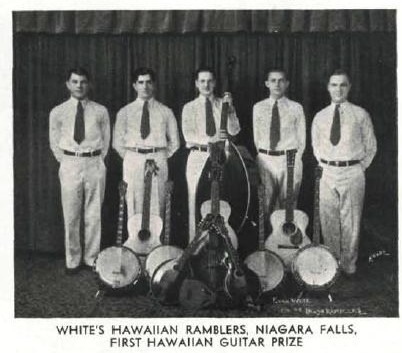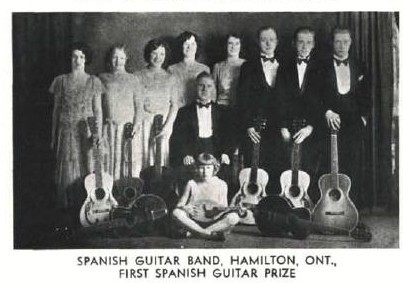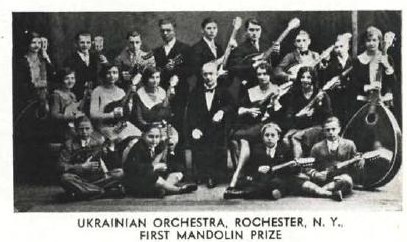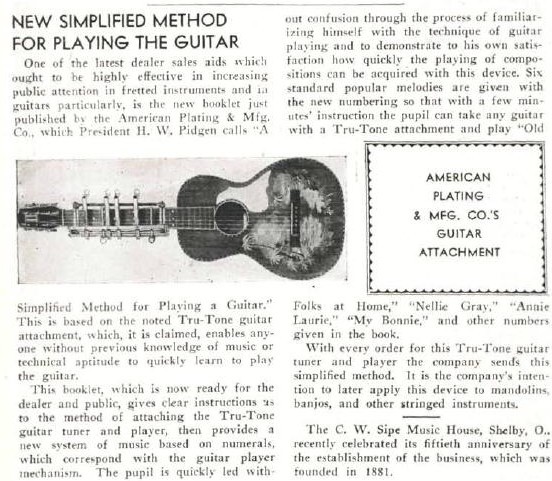| Music Trade Review |
|
Die Zeitschrift Music Trade Review ist online verfügbar: |
|
Music Trade Review - Music
Industry Magazine
Online Library: 1880 - 1933, 1940-1954 The Music Trade Review was published out of New York from 1878 until at least 1956. It apparently suspended publication with the January 1933 issue. Publication was resumed under different management sometime between 1937 and 1940. Our online library contains issues from 1880 to 1933, and from 1940 to 1954. Additional years are available for review at a number of libraries. Search www.worldcat.org for more information about the holdings of other libraries, or ask your local librarian for assistance. |
| |
| --
google Anzeige -- |
| Bitte
teilen sie diese Seite: |
 The Famous Santos Banjo Band, Rochester, N. Y. |
Source: |
|
Pizzitola Strummers, First Prize Banjo White's Hawaiian Ramblers, Niagara Falls, First Hawaiian Guitar Prize |
SECOND ANNUAL BANJO CONTEST PROVES BIG SUCCESS IN ROCHESTER, N. Y.ALTHOUGH it was officially entitled the Second Annual Santos National Banjo Band Concert, the most successful gathering of fretted instrument players in Rochester, N. Y., on April 24 and 25, included in addition to banjo bands, mandolin orchestras, Spanish and Hawaiian guitar bands, mandolin groups and prominent soloists on those several instruments. Several hundred fretted instrument artists participated before crowds that packed the convention hall. The contest itself was held on Friday, April 24, with some dozen or more bands taking part, and on Saturday afternoon the contest finals were held with the following results: the first banjo prize, Pizzitola Strummers, Holyoke, Mass., who also won last year's contest; second banjo prize, Hagadorn's Banjo Band, Hornell, N. Y; third banjo prize, Knapp's Banjo Band, Elmira, N. Y., and fourth prize, Brattain's Banjo Band, of Sandusky, O. First mandolin prize, Ukrainian Orchestra, Rochester, N. Y.; second mandolin prize, Nilodnam Quintet, Boalsburg, Pa. Fox Spanish guitars, Boote Spanish Guitar Band, Hamilton, Ont., and for Hawaiian guitars, White's Hawaiian Ramblers, Niagara Falls, N. Y. Public interest was strongly centered on the great music festival held on Friday eveningwith many prominent soloists and organizations participating, including William B. Mc- Michael, banjoist, Youngstown, O.; Rose Helen Pizzitola, mandolinist, Holyoke, Mass.; Evan White and His Banjo Ramblers, Niagara Falls, N. Y.; Marjorie Roach, banjoist, Syracuse, N. Y.; Boote Trio, Hamilton, Out.; Evangeline French, reader, Rochester, N. Y.; Hagadorn Duo, banjoists, Hornell, N. Y.; Brattain Banjo Band, Sandusky, O.; Ralph Wingert, banjoist and guitarist, Harrisburg, Pa.; Crandalls Happy Hicks, banjoists, Syracuse, N. Y.; Frank Staffa, banjoist-guitarist, New York; Frank Wagenknecht, 'cello banjo soloists, Holyoke, Mass., and Fred. J. Bacon, banjoist, Groton, Conn. This varied and pleasing program was opened by the Santos Banjo Band of eighty pieces. Following this two-hour program, a local broadcasting station, WHEC, featured an hour's broadcast, direct from the stage in which many visiting artists were featured. Among them: Kenneth Warren, banjoist, Binghamton, N. Y.; Miss Emma Murr, vocalist, White Plains, N. Y.; Laura Grassey and Jean Robinson, guitarists from Welland, Ont.; Lloyd Hagadorn and Allison Ordway, banjoists, Hornell, N. Y.; William B. Mc- Michael and Larry Warmcastle, guitarists, Youngstown, O.; Bacon Banjo Boys, Albany, N. Y.; Crandalls Happy Hicks, banjoists, Syracuse, N. Y., and Frank Staffa, guitarist, New York City. Following the concerts the audience and artists adjourned to the annex where there was dancing to the music of an excellent orchestra. A number of manufacturers of fretted instruments had special displays during the period of the contest, they including Gibson, Inc., Kalamazoo, Mich.; Bacon Banjo Co., Groton, Conn.; Vega Co., Boston, Mass.; H. A. Weymann & Son, Philadelphia, Pa.; Oahu Publishing Co., Cleveland, O., and the Santo Publishing Co., Rochester. Source: http://mtr.arcade-museum.com/MTR-1931-90-6/52/ http://mtr.arcade-museum.com/MTR-1931-90-6/53/ http://mtr.arcade-museum.com/MTR-1931-90-6/56/ |
 Spanish Guitar Band, Hamilton, Ont., First Spanish Guitar Prize
Ukrainian Orchestra, Rochester, N. Y., First Mandolin Prize |
AMERICAN GUILD HOLDS THIRTIETH ANNUAL CONVENTION IN MEMPHISTHE thirtieth annual convention of the American Guild of Banjoists, Mandolinists and Guitarists was held in Memphis, Tenn., on May 7, 8 and 9 with headquarters at the Peabody Hotel and it proved one of the most successful gatherings in the history of the organization with a large attendance and a constant round of activities throughout the three days. The Guild convention reached Memphis at a particularly opportune time for it was National Music Week and the Southern city gave full recognition to that important event. The result was that the fretted instrument bands and orchestras took part with other bands and drum corps in the great Music Week parade which was held on May 8. This was in addition to the annual parade of the Guild members themselves which was held on the opening day, May 7, with over a score of organizations in line. On the night of May 7 there was the annual musical show in which appeared fretted instrument stars from all sections of the country including Walter T. Holt, mandolinist of Washington, D. C.; Emma M. Murr, guitarist of White Plains, N. Y.; Fred J. Bacon, the famous banjoist of Groton, Conn., and many other individual artists and popular organizations. There was also much fretted instrument music on May 8 when the visitors enjoyed a barbecue and picnic which occupied most of the afternoon and evening. The members of the Guild also presented a program over the radio on Friday, the artists being Fred J. Bacon, Laura Mason Crisp, and Lee Keener, giving a program over station WMC. Walter T. Holt of Washington, president of the Guild, at the opening business session sounded a warning against the increasing number of claims that anyone can be taught to play the banjo, mandolin or guitar in a half dozen easy lessons, declaring that teachers should never lower their standards of instruction for the sake of easy money. "While our fretted instruments are not so difficult to learn as for example the piano, the notion that anybody can pick the knowledge of them is folly. One must learn something about music in general and must learn the instrument in particular as well." The fake teacheris doing irreparable damage, he declared. Mr. Holt stated that the teaching members of the Guild were getting along very well and that the sale of mandolins, guitars and banjos indicated a healthy interest on the part of the public. The guitar and mandolin, he stated, were again coming into their own in popular favor, supplanting in turn the saxophone and banjo which forced them into the shadow for the time being. Various divisions of the Guild held conferences during the convention for the discussion bf various matters concerning their favorite instruments, particularly matters bearing on the teaching of the instrument. Officers elected for the ensuing year were Walter T. Holt of Washington, president; and Miss S. Franklin Harvey of Washington, secretary-treasurer, both re-elected; William B. Griffiths, Atlanta, vice-president; and James II. Johnstone, Kalamazoo, Mich., Conrad Gebelein, Baltimore; Frank B. Campbell, Kalamazoo; Joseph Nicomede, Altoona, Pa.; and Mary G. Dodds, Atlanta, directors. The 1932 convention will be held in Washington, D. C. |
 NEW SIMPLIFIED METHOD FOR PLAYING THE GUITAROne of the latest dealer sales aids which ought to be highly effective in increasing public attention in fretted instruments and in guitars particularly, is the new booklet just published by the American Plating & Mfg. Co., which President H. W. Pidgen calls "A Simplified Method for Playing a Guitar." This is based on the noted Tru-Tone guitar attachment, which, it is claimed, enables anyone without previous knowledge of music or technical aptitude to quickly learn to play the guitar. This booklet, which is now ready for the dealer and public, gives clear instructions us to the method of attaching the Tru-Tone guitar tuner and player, then provides a new system of music based on numerals, which correspond with the guitar player mechanism. The pupil is quickly led without confusion through the process of familiarizing himself with the technique of guitar playing and to demonstrate to his own satisfaction how quickly the playing of compositions can be acquired with this device. Six standard popular melodies are given with the new numbering so that with a few minutes' instruction the pupil can take any guitar with a Tru-Tone attachment and play '"Old Folks at Home," "Nellie Gray," "Annie Laurie," "My Bonnie," and other numbers given in the book. With every order for this Tru-Tone guitar tuner and player the company sends this simplified method. It is the company's intention to later apply this device to mandolins, banjos, and other stringed instruments. Source: http://mtr.arcade-museum.com/MTR-1931-90-6/52/ |
|
|
>>> Zurück zum Inhalt - Back to the Contents <<< |
| Wenn
sie diese Seite
ohne Navigationsleiste angezeigt bekommen, dann klicken sie hier um die MandoIsland Homepage zu öffen: |
 |